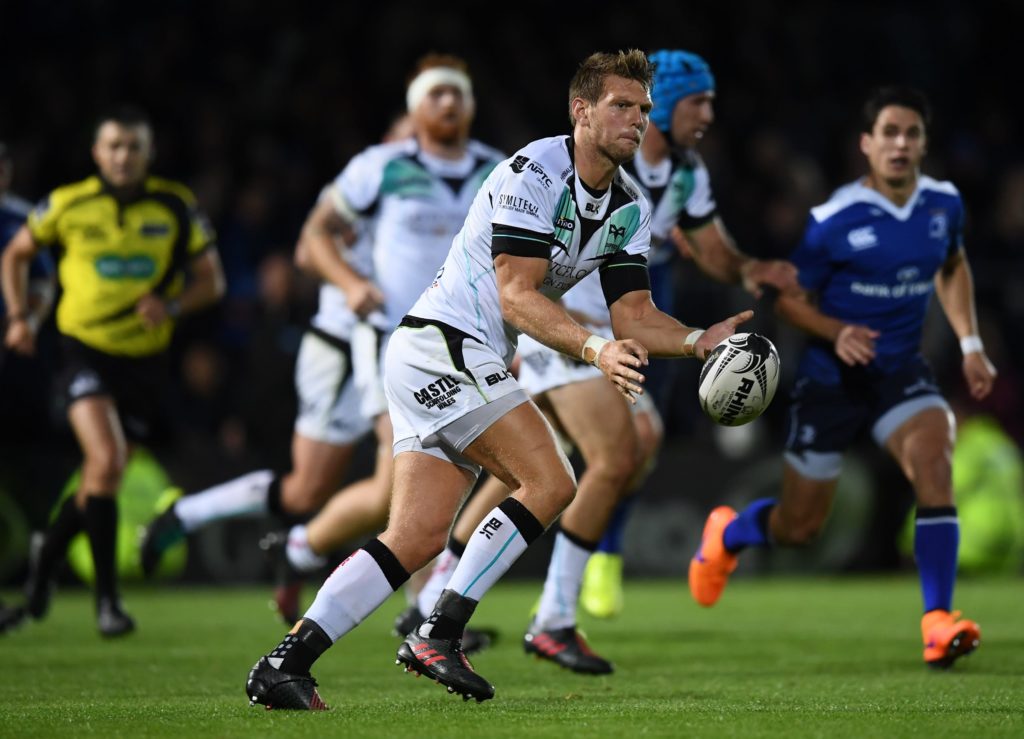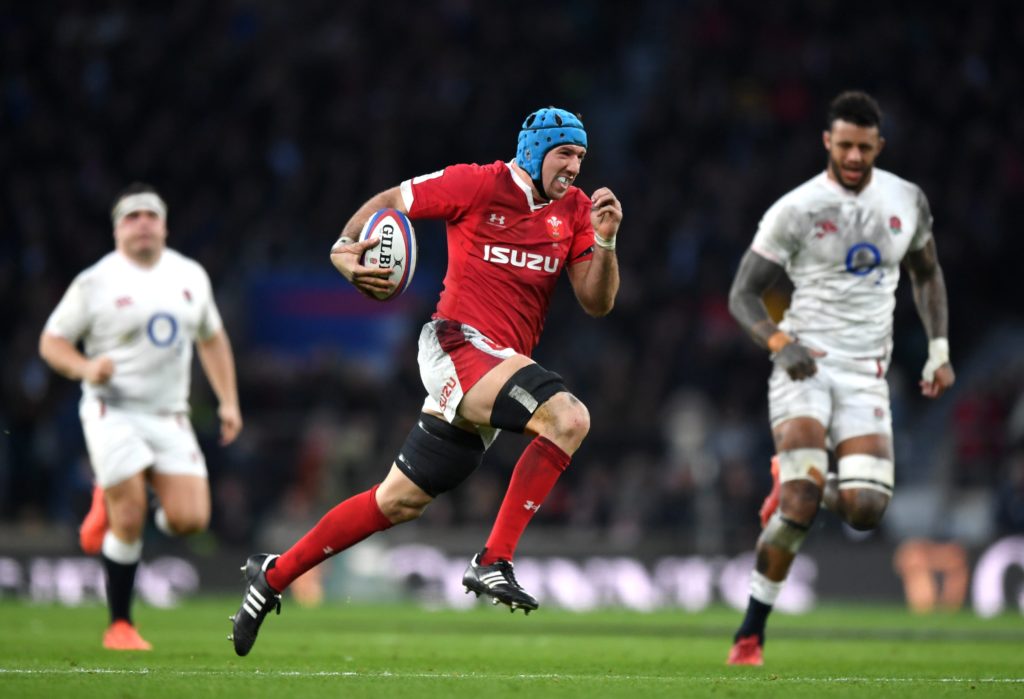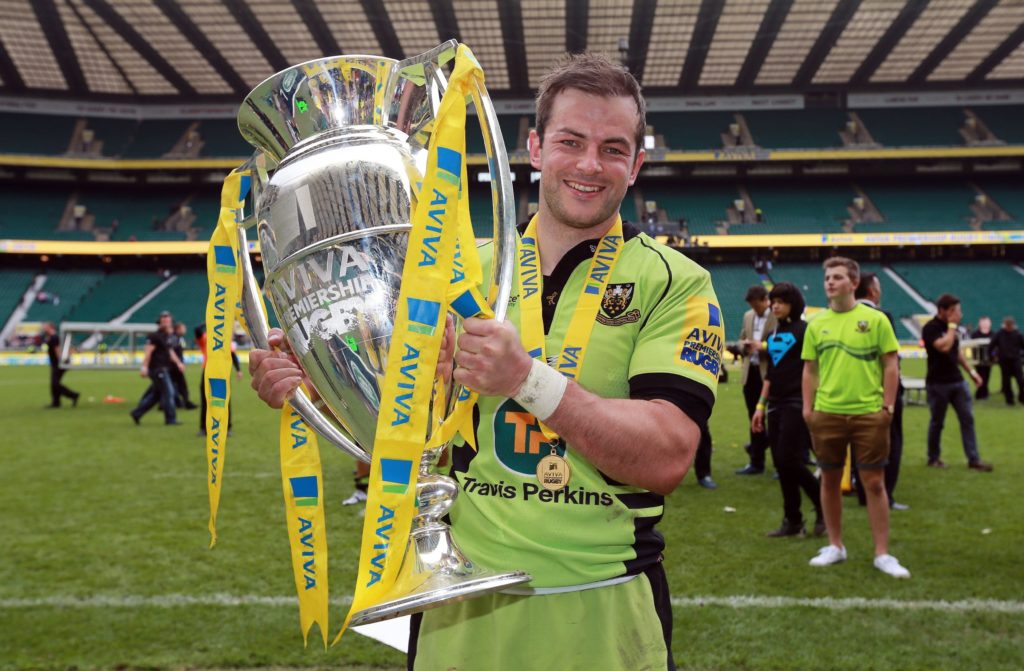It’s not creaking limbs or a receding hairline that make Stephen Myler feel his age. Far from it; he has a full head of hair and is rugby’s version of Cristiano Ronaldo according to Rhys Webb. It was an incident in the gym that laid bare the size of the age gap between a man in his 19th season of senior rugby and a teenager in his first.
Seizing control of the playlist, Myler put on ‘Movin’ Too Fast’ by Artful Dodger and Romina Johnson to the nodding approval of his contemporaries. The old-school garage track was a dancefloor anthem at the turn of the century. “What the **** is this?” came the cry from a puzzled Joe Hawkins.
Outraged that the youngster was ignorant of a stone-cold classic, Myler quickly calculated that Hawkins didn’t even exist when the record climbed its way to No2 in the UK singles chart. That was the moment Myler realised he was the elder statesman. At 18, Hawkins is literally half Myler’s age.
“Yeah, thanks for that,” Myler deadpans when I point it out. It’s something he has become used to as he enters the twilight of his career – the inevitable age references. “It doesn’t occur to you when you’re just talking about rugby stuff on the field, but occasionally you realise these guys are totally unaware of stuff that you grew up with. I’m the old man now,” he said. “But it’s all good fun and it keeps me young. I’m getting used to the abuse.”
It probably helps that I’m not in the engine room having my head kicked in every week. Unlike the forwards, I’m not having my neck twisted in every conceivable direction.
Ospreys fly-half Stephen Myler
At 36, Myler has outlasted all his fly-half contemporaries in Europe, yet is showing no signs of easing up. A few weeks after 38-year old Dan Carter lowered the curtain on his glittering career, Myler is not even contemplating his exit from the stage.
There’s no secret to his longevity; no elixir of eternal youth or rigorous pilates regime, just a combination of good fortune and the fact he operates in the game’s open spaces rather than at the coal face.
“It probably helps that I’m not in the engine room having my head kicked in every week,” he said. “Unlike the forwards, I’m not having my neck twisted in every conceivable direction. That said, I do have to look after myself more than I did when I was 21; that comes with the territory. My stretching regime is pretty much the same as it’s always been, it just takes a bit more effort in terms of recovery, preparation and diet.
“I can’t get away with the things I did when I was 20, when you’re rolling out of bed and straight on to the pitch without any warm-ups. I haven’t got any intention of stopping at the moment because as the cliche goes, you’re a long time retired.”

Myler rejects the notion that he’s in his late thirties though, saying 2020 should be written off. “We’ll stick with mid-thirties if you don’t mind,” he says with a laugh. “I’ve lost a year because of Covid, so I’m still 35 as far as I’m concerned.”
His seniority brings extra responsibilities. Ospreys head honcho Toby Booth has described him as an extra coach on the field; the guy who “stitches things together”, and his presence at the Liberty Stadium has undoubtedly had a stabilising influence.
For two years, the Ospreys struggled to fill the Dan Biggar shaped void at No10. Sam Davies, Biggar’s long-term understudy, left. Star signing Gareth Anscombe has yet to play and Marty McKenzie’s cameo was almost Hitchcock-ian in its brevity and incongruity.
When I came across from rugby league and didn’t have clue what was going on, I was surrounded by older heads who helped me understand the game. I now have that role for these guys at the Ospreys.
Myler’s experience, nous, and goal-kicking accuracy has encouraged those around him to flourish. It’s a role he savours and it mirrors the situation he found himself in early in his union career.
“When I came across from rugby league and didn’t have clue what was going on, I was surrounded by older heads who’d been around the block and coaches who helped me understand the game. I now have that role for these guys at the Ospreys; to help them understand why we’re trying to do things, and how they can have an influence on the game.”
The Ospreys’ ‘Galacticos’ era has long gone. The largesse on show in the Noughties, when luminaries like Justin Marshall, Marty Holah and Jerry Collins could be lured to the Liberty has evaporated. The model is now to nurture and develop local youngsters, and Myler likes what he sees.
“What struck me when I came here was the fact there are more than one or two boys that have really got something about them. With the right development programme and the right amount of game-time, they could really progress and be a staple of the Ospreys team for years to come,” he says. “It’s a privilege for me that I can play a part in their development.”
The elder statesman is reluctant to highlight individuals, but there are certain names that have been at the tips of commentators’ tongues all season because of their eye-catching contributions.
“Kieran Williams has been really impressive, Matt Protheroe has made a real impact since he’s come in; I was already aware of his talent having played against him in the Premiership. Then you’ve got Joe Hawkins, who’s 18. He doesn’t know who Artful Dodger are, but he can really play rugby,” said Myler.

While he’s more than happy to pass on his wisdom and experience, he considers it a two-way street. As well as hosting a stable of raw, exciting youngsters, the Ospreys remains the home of some world-class players still operating at the peak of their powers.
“That was a big part of why I wanted to come and play here,” he said, “to play alongside and learn from blokes like Alun Wyn, Justin Tiupric and Dan Lydiate. It’s obvious why they’ve had the kind of success they’ve had. Alun Wyn is as keen and as demanding as he has ever been. You don’t play that many Tests and have as big an impact in the game if you aren’t wired that way. He’s a year younger than me, but you wouldn’t think he’s nearing the end. Far from it.”
Jones’ limitless enthusiasm is clearly infectious, and chimes with Myler’s philosophy that you never stop learning. “The game evolves every year or two” he says. “Working with new coaches constantly opens your eyes to different perspectives. There are amendments in the laws, new interpretations. There are different defensive structures in place now than there were five years ago and, coming to a new club, the attacking structures are always going to be different so you have to get up to speed with that.
“I can’t just come in and think, I’ve been playing rugby for X amount of years, I’ve got this down to a tee. The minute you think you’ve got nothing to learn or nothing to prove, you’re done.”
His admiration extends to another evergreen Osprey, whose obvious talents are even more apparent close up. “Justin Tipuric is even more sublime in person,” he says.
“When you’re around these players every day you appreciate what they bring to the table. Justin can play 6,7, or 8 with ease, could probably play lock and could play anywhere in the backline. He has an outrageous skillset but, first and foremost, he’s physical. He competes hard for the ball, and tackles his heart out. He can do pretty much everything, which is really uncommon. Some of the backs have the skillset he has but ask them to go in a scrum or a lineout, and they’d run a mile. I knew this guy was good but he can literally do everything.”

The respect between Myler and his new team-mates is mutual, though he remains suspicious about Webb’s “Ronaldo” comparison. “Isn’t it just the age thing?” he asks, pointing out they were born in the same year. I suggest he was referring to Myler’s physical condition and youthful appearance, and he softens a bit. “Oh really? I thought it was the age thing, but if he’s talking about being in similar nick, I’ll take it. Although Webby’s probably got more in common with him in terms of the Madeira tan than I have. He has claimed Maltese roots in the past and that his tan is au naturel, but I have my doubts.”
If the provenance of Webb’s tan is a mystery, so too is his absence from the Wales squad, particularly when a vacancy arose in light of Tomos Williams’ hamstring tear. The Liberty faithful are baffled at the notion that Webb is – at best – Wales’ fifth-best scrum-half. His back-to-back man-of-the-match displays against Connacht and Zebre gave evidence of his enduring qualities. Resisting the temptation to dip his toes in the broiling waters of Welsh rugby politics, Myler merely points out that Wales’ loss is the Ospreys’ gain.
“I’ve really enjoyed playing with Rhys. There has been a lot of chat about his omission from the Welsh squad but I won’t delve into that. What I will say is that Rhys is a quality player and he has really helped me in my time here. I’ve quickly developed a partnership with him and his last few performances have shown that he has still got what it takes,” said Myler.
He has been an Osprey, an Exile, and a Saint. But Myler’s rugby adventure began as a Viking, playing for his hometown team in the 13-man code. Hailing from Widnes, it was no surprise that his formative years were spent playing league. His father John and uncle Tony also played for Widnes, sharing the field with other famous cross-coders like Jonathan Davies, Alan Tait and Martin Offiah. Tony went on to play 14 times for Great Britain. The dynasty stretches back to Stephen’s great uncle, Frank Myler, who was the last British captain to win a Test series in Australia.
The road from league to union is now so well travelled it’s a virtual three-lane highway, but the most successful converts are usually those in positions that require instinct and speed rather than tactical mastery. In that respect, Stephen Myler is a rarity. A league-to-union convert who has mastered the ‘foreign code’ in the most demanding position of all.
“It hadn’t really been done before,” he remembers. “People had either gone the other way, or if they did switch from league to union, they ended up as outside backs, Jason Robinson being the prime example. Henry Paul played centre, Andy Farrell played centre when he came across. No one had really played 10, but that was my position in league and it was going to be my position in union.”
Initially, I was shocked at how different the game was. I hadn’t played a full game of union when I was in school so all I had to go off was what I’d seen on TV.
Myler on his switch from league to union
To the uninitiated, it may not seem that bumpy a transition, but a fly-half in union is the tactical heartbeat of the team, the conduit through which most decisions are made. Tens are expected to make split-second decisions in the blink of an eye, to react to an ever-changing landscape with the cool detachment of a chess player. It doesn’t come easy.
“Initially, I was shocked at how different the game was,” he admits. “I hadn’t played a full game of union when I was in school so all I had to go off was what I’d seen on TV. The first two games I played for Northampton, I just ran around aimlessly. I got 20 minutes at full-back in the first and played on the left wing in the second. It was all a bit frantic and I didn’t really get it. It wasn’t until the third game, when they picked me at 10, that I remember coming off and thinking, ‘I’ve got this. I think I understand the flow and what I need to do’.”
Twelve seasons later, he’d racked up 325 appearances for the Saints, and scored 2,618 points. Only two players have ever scored more. It’s fair to say his conversion has been a successful one.
Welsh readers of a certain generation considered rugby league the sport of the devil for spiriting away so many of Wales’ finest players, but in Myler’s experience, there has never been any enmity between the two codes. To have embraced one doesn’t mean rejecting the other, and he’s equally grateful to both.

“I see each one for what it is,” he says. “I still watch rugby league regularly and am glad of my upbringing from it. It has given me a lot. The Myler name is still going because Richie (Myler’s cousin) is still playing in Super League. I’m playing in union and have been for a while. [Switching codes] has never been something I’ve focused on or my family have talked about. I’ve just played the game and really enjoyed it, and it just happens that family members before me have played. I’m proud that I’ve added something to it.”
And he continues to add value in his own humble, unfussy way. Booth’s reference to him as the glue holding the team together may hint at a future in coaching, but he has yet to decide. Being the tactical fulcrum of the team for so long, he says, naturally lends itself to coaching.
“The more experienced you become and the more knowledge you accumulate, the better you’re able to help people develop personally and understand why we’re doing certain things in a certain way. That is coaching in a way but it’s also just your role as a 10,” he says. “It’s why a lot of 10s do go into coaching, because it’s almost a natural progression.”
His immediate ambitions are more modest. He just wants to see a bit of Wales after listening to his team-mates endlessly telling him how beautiful it is. “I chose to rent a place halfway between Swansea and Cardiff so I could see a bit of both, but I’ve seen nothing of either because of lockdown, so it has backfired a bit,” said Myler. “I can’t wait for lockdown to be lifted so I can actually get out and see a bit of the country, and some of the beautiful coastline I’ve heard so much about.”
In the meantime, he will continue to bring his influence to bear, to help the Ospreys secure a Champions Cup spot and, hopefully, to educate the younger generation about the dancefloor fillers of the early Noughties.
More stories by Ross Harries
If you’ve enjoyed this article, please share it with friends or on social media. We rely solely on new subscribers to fund high-quality journalism and appreciate you sharing this so we can continue to grow, produce more quality content and support our writers.


Comments
Join free and tell us what you really think!
Sign up for free